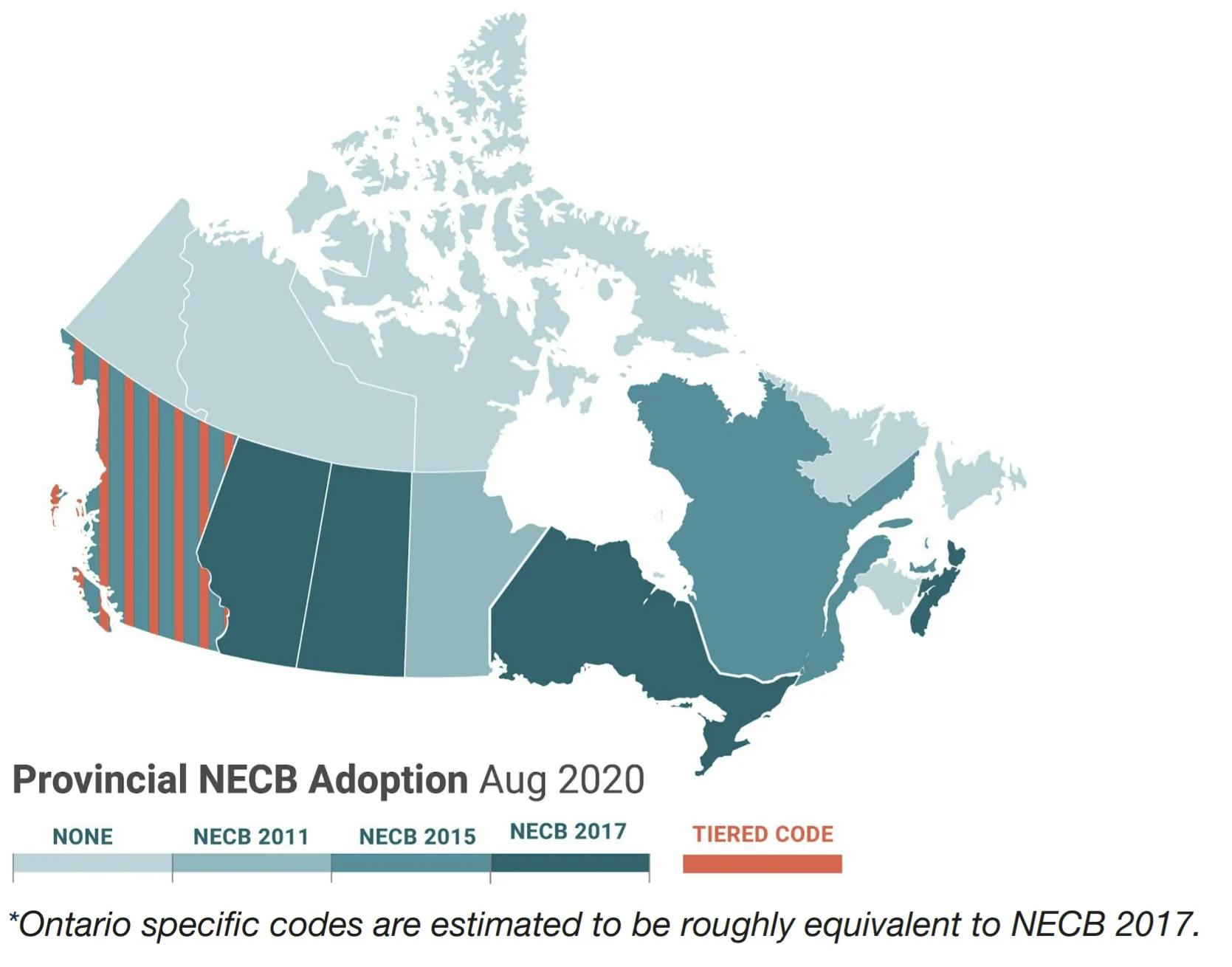Canada has played a critical role in the fight against climate change by enforcing energy standards across its provinces and territories. Established by the National Research Council and Natural Resources Canada, standards such as the National Energy Code of Canada for Buildings (NECB) have increased accountability for architects and engineers across the country by considering energy use in new building projects.
Energy Codes at the Provincial Level
According to the Climate Change Performance Index (CCPI), seven countries perform poorly in the Energy Use category, with Canada last among them. While Canada is continually making strides in the right direction, it is still a long way from achieving its energy use targets. Currently, only four of the ten provinces have adopted NECB 2017, making Alberta, Saskatchewan, and Nova Scotia the nation's leading regions in terms of sustainability. On the contrary, Quebec has adopted the 2015 code, and Manitoba has assumed the 2011 standard.
This article touches on the Canadian energy codes, how they differ between Canadian provinces, and how they compare to energy codes in its adjacent nations. The provincial-level energy codes can be seen in the map below.

//01 The National Energy Code of Canada for Buildings (NECB)
The National Energy Code of Canada for Buildings (NECB) was put in place by the National Research Council (NRC) to improve the energy efficiency of buildings and reduce harmful greenhouse gas emissions. It lays out technical requirements for energy-efficient design and construction of new buildings. As of now, there are three versions of the code (i.e., NECB 2011, NECB 2015, and NECB 2017). The 2015 version of the code addresses service water and introduces new requirements for pressure sensing controls, with 90 changes total between the 2011 energy code and the 2015 edition.
The most recent version of the model code became mandatory in several provinces in 2017 and has since changed the way Canadian architects approach building design. With NECB in place, concerns regarding energy use and energy code compliance have become commonplace among architects and engineers.
Implementing NECB 2017 is an essential step towards achieving Canada's goals for new buildings. In addition to the changes made to the 2015 version, NECB 2017 includes reducing the overall thermal transmittance of roofs, fenestration, and doors. To achieve compliance with NECB 2017, architects must modify their existing workflows, implementing practices such as energy modeling in early-stage design. Coordination between the design of walls, roofs, and mechanical systems will become a vital part of the design process. Beyond energy code compliance, the interdisciplinary collaboration required to meet the goals will help environmentally conscious designers drive innovation in the AEC industry to act against climate change more quickly.
How do NECB to ASHRAE 90.1 Compare?
While NECB and The American Society of Heating, Refrigerating and Air-Conditioning Engineers (ASHRAE) 90.1 have similar compliance paths, key differences exist between the two codes. NECB provides architects, engineers, and designers with the flexibility to take multiple compliance paths with their building-design proposals. In contrast, ASHRAE has additional mandatory requirements for its compliance paths. Furthermore, ASHRAE 90.1 mainly considers energy cost, and NECB considers energy consumption to achieve compliance and NECB also outlines stricter policies for a building's thermal envelope than ASHRAE 90.1.
Help Article: Comparing the Energy Codes: US vs Canada
//02 The Toronto Green Standard (TSG)
Toronto City Council adopted the Toronto Green Standard V4 in 2021. TSG is Toronto's sustainable design requirement for new private and city-owned developments. The standard addresses air quality, water quality, and efficiency and includes solid waste and ecology objectives for new developments in the city of Toronto.
The standard is one of the key actions the City of Toronto is taking towards achieving its TransformTO goal to achieve net zero greenhouse gas emissions by 2050. Among its many requirements, the standard includes advancements including electric vehicle parking, and introducing new ways to track the total embodied carbon emissions of building materials. The new amendments to the code will apply to development applications in the second quarter of 2022.
Help Article: cove.tool and Toronto Green Standard (TGS)
//03 Canada's Zero Carbon Building Standard (ZCB)
Along with NECB and TSG, Canada has devoted itself to achieving net-zero carbon emissions by 2050 by introducing the Zero Carbon Building Standard (ZCB). The standard provides pathways for new and existing buildings to help with the goal and offers certifications as recognition for industry leaders. The certification is worn as a "badge of honor" and can be used by firms to win more clients and display their commitment to reaching net-zero carbon emissions.
Currently, there are two versions of the ZCB Standard, with Version 2 focusing on the carbon balance of buildings across their life cycle. This includes construction and operation and applies to all facilities, excluding small multifamily and residential buildings.
The standard was developed based on learnings from real-world projects for new and existing buildings. The latest ZCB Standard aims to encourage widespread adoption by providing multiple energy efficiency paths to choose from. It also includes criteria such as airtightness testing, a requirement to offset embodied carbon and refrigerants, the requirement for impactful and innovative technologies, and the use of new and improved tools and resources.
Help Article: Canada's Zero Carbon Building Standard (ZCB)
Energy Code Compliance
Climate change is a growing concern throughout the world. While we still have a long way to go regarding international advocacy, many countries are taking steps in the right direction. Nations such as Canada and the United States are making rapid advancements towards achieving net-zero carbon emissions, implementing renewable energy sources and sustainable practices, and building energy optimization in the AEC industry.
We can expect to see new energy code developments in the coming years, with the intention of improving Canada’s built environment. In the meantime, meeting the requirements of Canadas existing model codes can be achieved through various methods, including energy modeling in early-stage design.
Learn More: cove.tool: Building Performance Analysis Tool

